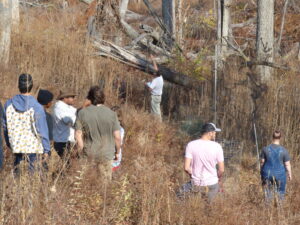
A chickadee gently cradled in man’s hand.
On an early, warm, bright November day, several Coe and Mt. Mercy University Students with their professors arrived at Winding Pathways to band birds. They stood mesmerized as one cradled a diminutive bird in his hand. This long-distance traveler had met a temporary misfortune.
It was a golden-crowned kinglet, a tiny bird tipping the scales at only .19 ounce. On a recent night, it had winged south from its summer home in the north and decided to rest and feed amid the tall grass and woods at Winding Pathways. Then, it would continue southward. It didn’t know that Dr. Neil Bernstein had other plans.
- Dr. Bernstein sets a mist net by a fallen log.
- trapped chickadee
- Untangling bird
Neil had stretched mist nets an hour earlier. The kinglet, along with chickadees and a Carolina wren didn’t see these fine mesh nets in time. They were caught but uninjured. Neil showed the students how to band birds by gently removing them from the net, weighing each tiny bird, recording data, placing a small lightweight band around its leg, and releasing it. Data are then submitted to help researchers better understand bird migration.
The kinglet and wren waited patiently as students weighed and banded each, but not the chickadees. These bitty, year-round residents have an attitude. They didn’t like being held one bit and pecked at the student’s fingers.
- A bird’s claws poke through the bag.
- Verifying information is important.
- Tiny band ready to attach to a bird
- Checking feathers
Student Reactions
Students were used to collecting scientific data on different natural topics. They were fascinated by the process of banding birds. “I thought we were going to listen to a bird band!” joked one student. Another envisioned running around chasing birds, concluding that would not work well.
Students commented on how the pecks were sharp but not worrisome. One explained she talked quietly to the chickadee as she carefully held it. Reassuring the bird, she would not hurt it. “I could feel its heart rate slow down,” she commented.
Although chickadees are small, kinglets are even smaller. This kinglet will carry its band as it wings southward but chickadees are homebodies and will wear their bands as they flit around our yard all winter.
Why Band Birds?

Tiny band with a number.
Banding is a traditional way of learning where birds go, habitat needs, and the impact of climate on both. Perhaps a fellow bander will catch “our” kinglet and inform scientists at the US Geological Survey.









It’s fascinating to me that the student could feel the birds heart rate slow down. Of course, it was very frightened. Interesting to know that it responded so well to human interaction and comforting.
Isn’t that cool, Jan! Thanks for noting that. The young lady had a lovely spirit. M~